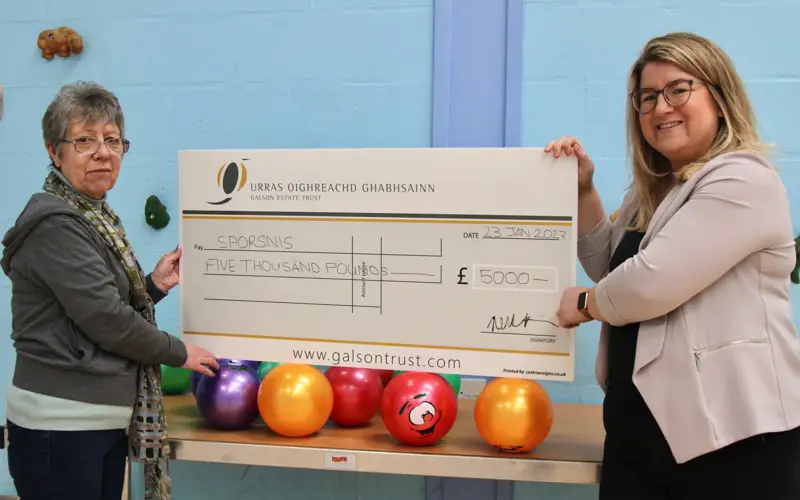Creating a place for all generations and families to live well and flourish locally is fundamental to retaining and attracting people. We want to encourage people to remain here and make a positive contribution to our economy, and our community.
Local people at the heart of developing place
Find out more from Jemma MacVicar, Àrd-oifigear at Urras about how they operate, and the services and benefits community ownership brings.
The Urras was established in 2007 as a company limited by guarantee and a registered charity. It operates via a Strategic Plan which has been developed through extensive community engagement.
There is a board of volunteer directors who are elected from the membership. They employ 16 members of staff (both full-time and part-time) to deliver the day-to-day operations of the company and its related entities.
Galson Estate (Trading) Ltd carries out trading activity around assets whilst renewable energy operations are undertaken by Urras Energy Society and Galson Energy Ltd.
Crofting administration and advice – service provided locally to assist with house sites, access for services, croft assignations, lettings, property sales, etc. plus commercial negotiations with communications operators and utilities
Health and wellbeing – Sunnd programme operates over winter months offering a range of events and activities to reduce social isolation, improve mobility and fitness, promote nutrition and healthy eating, manage finances and energy consumption, enhance creativity, increase safety, etc.
Cost of living – supply of essential items over winter period to elderly residents and vulnerable/disadvantaged adults, subsidising of children’s and adult’s events and activities plus signposting residents in hardship to other support services
Tourism – dedicated website and app for visitors together with operation of campervan pitches with public toilets and shower
School holiday clubs – Plòigh programme delivers a wide range of activities during Easter/summer/autumn holiday periods for pre-school, primary and secondary age children
Waste management – operation of all-year round recycling facilities
Community Investment Fund – redistributes wind income to community organisations in the form of grants for a range of activities such as heritage, culture, sports and recreation, health and wellbeing, care and education in line with the Strategic Plan
Project Co-ordination – assistance with planning and delivering significant capital initiatives undertaken by local organisations (linked to major applications through the Community Investment Fund)
The Urras is guided by its 2017-37 Strategic Plan, which was updated in 2022. This focuses on four priorities – health and wellbeing, tourism, land use and crofting plus exceptional place. This is a framework which helps to determines which initiatives and projects are supported and taken forward. Pipeline initiatives include :
- Housing and extra-care accommodation through partnership with public agencies
- Tourism facilities at the Butt of Lewis Lighthouse
- Extension of arts and music facilities
- Port of Ness harbour improvements
- Celebrating the centenary of Galson Crofting Township
- Investigating opportunities for further onshore wind energy investment
Whilst the Urras benefits from its own independent income source, there are a range of challenges that the current economic pressures are creating. As a remotely based organisation, recruitment has been difficult and availability of suppliers has reduced in some cases. Capital funding for key projects has become more problematic to attract. Worsening fuel poverty has accelerated and hardship cases have increased in volume. Resources within public agencies have diminished which has added additional constraints on partnership working.
- The Urras has been able to foster a deeper engagement with the community and create its own agenda to deliver rural regeneration solutions.
- Constructive discussions and debates emerge on critical local issues that would not occur through private ownership. Formalised structures exist or can be created to channel collaboration and co-operation across the locality, as opposed to relying more on national or regional platforms in previous eras.
- There is more effective use of resources generally as the Urras intrinsically understands how the community functions. Community landowners can evolve into anchor organisations, winning and distributing external resources to local partners that might otherwise be lost. They also channel local views and contributions more effectively for formal regional/national consultations, thus ensuring local residents and organisations have more of a voice.
- Wealth building is generally more effective where community landowners can focus on utilising and developing local capacity and services. There is a clear link between ownership and land use, decision-making mechanisms differ significantly between private and community concerns.
- Effective partnership working can result in more decentralisation of public services where the community landowners create the necessary local support for activities to be delivered locally. These activities can then be tailored to address particular local needs.
- Where income streams are secured, employment levels can rise to significant levels within the community. Community landowners such as the Urras can evolve into exemplar socially responsible employer which helps to raise standards across the area. Prior to wind energy incomes being secured, the Urras employed three staff.
- Networking between community landowners can lead to knowledge transfer, sharing of resources, alignment of priorities, co-operation in the delivery of key services, increased economies of scale through partnership working.
Whilst perhaps not areas of much interest at the outset, policy development, succession and knowledge transfer become more pertinent over time. Regular community engagement is essential to being able to deliver future plans, as are effective partnerships within and outwith the Estate.
Urras are a great example of the impact that community ownership, combined with independent income, can have on a local area. It gives them the autonomy to provide bespoke local services, draw in additional funds and prioritise their investments.
Can we help you?
Find out more about who we work with and how we can help.





